Juan Nathaniel
CausalDynamics: A large-scale benchmark for structural discovery of dynamical causal models
May 22, 2025Abstract:Causal discovery for dynamical systems poses a major challenge in fields where active interventions are infeasible. Most methods used to investigate these systems and their associated benchmarks are tailored to deterministic, low-dimensional and weakly nonlinear time-series data. To address these limitations, we present CausalDynamics, a large-scale benchmark and extensible data generation framework to advance the structural discovery of dynamical causal models. Our benchmark consists of true causal graphs derived from thousands of coupled ordinary and stochastic differential equations as well as two idealized climate models. We perform a comprehensive evaluation of state-of-the-art causal discovery algorithms for graph reconstruction on systems with noisy, confounded, and lagged dynamics. CausalDynamics consists of a plug-and-play, build-your-own coupling workflow that enables the construction of a hierarchy of physical systems. We anticipate that our framework will facilitate the development of robust causal discovery algorithms that are broadly applicable across domains while addressing their unique challenges. We provide a user-friendly implementation and documentation on https://kausable.github.io/CausalDynamics.
Deep Koopman operator framework for causal discovery in nonlinear dynamical systems
May 20, 2025Abstract:We use a deep Koopman operator-theoretic formalism to develop a novel causal discovery algorithm, Kausal. Causal discovery aims to identify cause-effect mechanisms for better scientific understanding, explainable decision-making, and more accurate modeling. Standard statistical frameworks, such as Granger causality, lack the ability to quantify causal relationships in nonlinear dynamics due to the presence of complex feedback mechanisms, timescale mixing, and nonstationarity. This presents a challenge in studying many real-world systems, such as the Earth's climate. Meanwhile, Koopman operator methods have emerged as a promising tool for approximating nonlinear dynamics in a linear space of observables. In Kausal, we propose to leverage this powerful idea for causal analysis where optimal observables are inferred using deep learning. Causal estimates are then evaluated in a reproducing kernel Hilbert space, and defined as the distance between the marginal dynamics of the effect and the joint dynamics of the cause-effect observables. Our numerical experiments demonstrate Kausal's superior ability in discovering and characterizing causal signals compared to existing approaches of prescribed observables. Lastly, we extend our analysis to observations of El Ni\~no-Southern Oscillation highlighting our algorithm's applicability to real-world phenomena. Our code is available at https://github.com/juannat7/kausal.
Generative emulation of chaotic dynamics with coherent prior
Apr 19, 2025Abstract:Data-driven emulation of nonlinear dynamics is challenging due to long-range skill decay that often produces physically unrealistic outputs. Recent advances in generative modeling aim to address these issues by providing uncertainty quantification and correction. However, the quality of generated simulation remains heavily dependent on the choice of conditioning priors. In this work, we present an efficient generative framework for dynamics emulation, unifying principles of turbulence with diffusion-based modeling: Cohesion. Specifically, our method estimates large-scale coherent structure of the underlying dynamics as guidance during the denoising process, where small-scale fluctuation in the flow is then resolved. These coherent priors are efficiently approximated using reduced-order models, such as deep Koopman operators, that allow for rapid generation of long prior sequences while maintaining stability over extended forecasting horizon. With this gain, we can reframe forecasting as trajectory planning, a common task in reinforcement learning, where conditional denoising is performed once over entire sequences, minimizing the computational cost of autoregressive-based generative methods. Empirical evaluations on chaotic systems of increasing complexity, including Kolmogorov flow, shallow water equations, and subseasonal-to-seasonal climate dynamics, demonstrate Cohesion superior long-range forecasting skill that can efficiently generate physically-consistent simulations, even in the presence of partially-observed guidance.
Deep Generative Data Assimilation in Multimodal Setting
Apr 10, 2024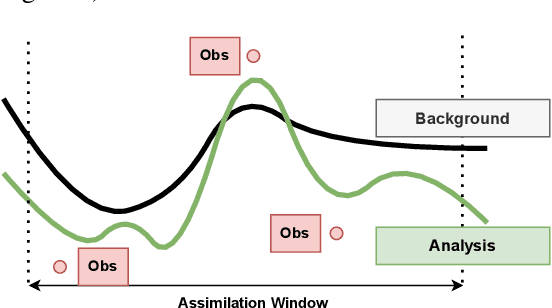
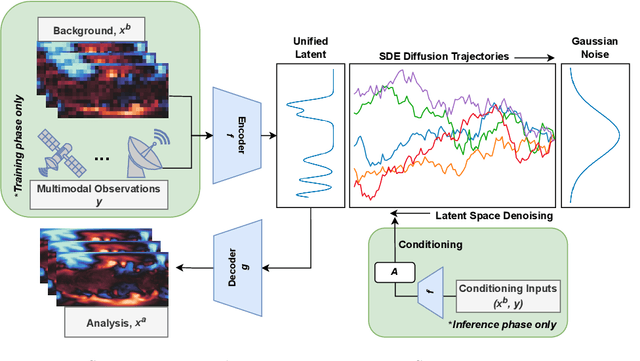
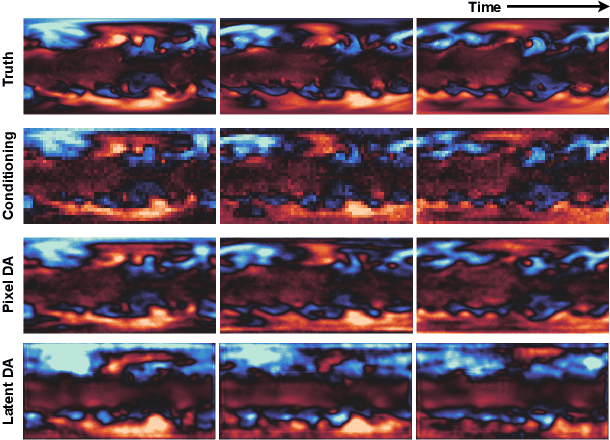
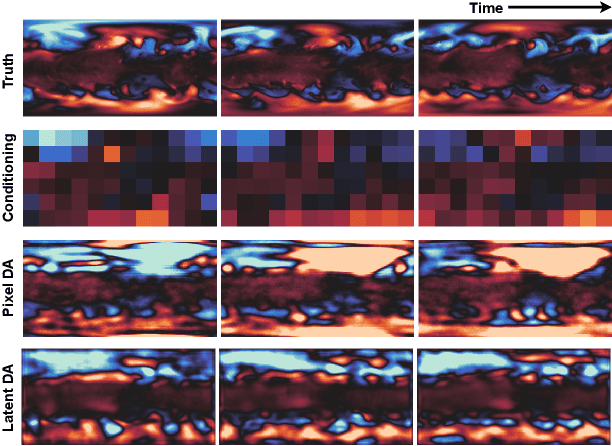
Abstract:Robust integration of physical knowledge and data is key to improve computational simulations, such as Earth system models. Data assimilation is crucial for achieving this goal because it provides a systematic framework to calibrate model outputs with observations, which can include remote sensing imagery and ground station measurements, with uncertainty quantification. Conventional methods, including Kalman filters and variational approaches, inherently rely on simplifying linear and Gaussian assumptions, and can be computationally expensive. Nevertheless, with the rapid adoption of data-driven methods in many areas of computational sciences, we see the potential of emulating traditional data assimilation with deep learning, especially generative models. In particular, the diffusion-based probabilistic framework has large overlaps with data assimilation principles: both allows for conditional generation of samples with a Bayesian inverse framework. These models have shown remarkable success in text-conditioned image generation or image-controlled video synthesis. Likewise, one can frame data assimilation as observation-conditioned state calibration. In this work, we propose SLAMS: Score-based Latent Assimilation in Multimodal Setting. Specifically, we assimilate in-situ weather station data and ex-situ satellite imagery to calibrate the vertical temperature profiles, globally. Through extensive ablation, we demonstrate that SLAMS is robust even in low-resolution, noisy, and sparse data settings. To our knowledge, our work is the first to apply deep generative framework for multimodal data assimilation using real-world datasets; an important step for building robust computational simulators, including the next-generation Earth system models. Our code is available at: https://github.com/yongquan-qu/SLAMS
ChaosBench: A Multi-Channel, Physics-Based Benchmark for Subseasonal-to-Seasonal Climate Prediction
Feb 01, 2024
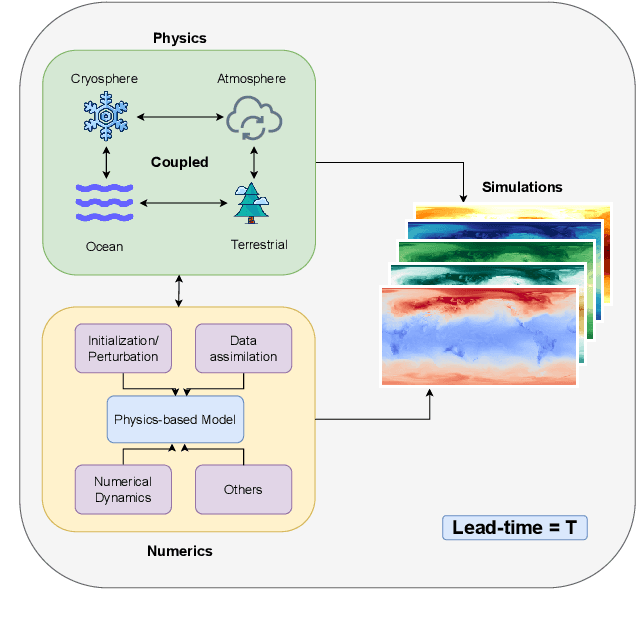

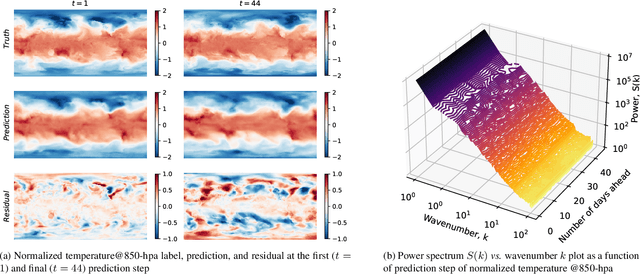
Abstract:Accurate prediction of climate in the subseasonal-to-seasonal scale is crucial for disaster readiness, reduced economic risk, and improved policy-making amidst climate change. Yet, S2S prediction remains challenging due to the chaotic nature of the system. At present, existing benchmarks for weather and climate applications, tend to (1) have shorter forecasting range of up-to 14 days, (2) do not include a wide range of operational baseline forecasts, and (3) lack physics-based constraints for explainability. Thus, we propose ChaosBench, a large-scale, multi-channel, physics-based benchmark for S2S prediction. ChaosBench has over 460K frames of real-world observations and simulations, each with 60 variable-channels and spanning for up-to 45 years. We also propose several physics-based, in addition to vision-based metrics, that enables for a more physically-consistent model. Furthermore, we include a diverse set of physics-based forecasts from 4 national weather agencies as baselines to our data-driven counterpart. We establish two tasks that vary in complexity: full and sparse dynamics prediction. Our benchmark is one of the first to perform large-scale evaluation on existing models including PanguWeather, FourCastNetV2, GraphCast, and ClimaX, and finds methods originally developed for weather-scale applications fails on S2S task. We release our benchmark code and datasets at https://leap-stc.github.io/ChaosBench.
Aboveground carbon biomass estimate with Physics-informed deep network
Oct 25, 2022Abstract:The global carbon cycle is a key process to understand how our climate is changing. However, monitoring the dynamics is difficult because a high-resolution robust measurement of key state parameters including the aboveground carbon biomass (AGB) is required. Here, we use deep neural network to generate a wall-to-wall map of AGB within the Continental USA (CONUS) with 30-meter spatial resolution for the year 2021. We combine radar and optical hyperspectral imagery, with a physical climate parameter of SIF-based GPP. Validation results show that a masked variation of UNet has the lowest validation RMSE of 37.93 $\pm$ 1.36 Mg C/ha, as compared to 52.30 $\pm$ 0.03 Mg C/ha for random forest algorithm. Furthermore, models that learn from SIF-based GPP in addition to radar and optical imagery reduce validation RMSE by almost 10% and the standard deviation by 40%. Finally, we apply our model to measure losses in AGB from the recent 2021 Caldor wildfire in California, and validate our analysis with Sentinel-based burn index.
 Add to Chrome
Add to Chrome Add to Firefox
Add to Firefox Add to Edge
Add to Edge